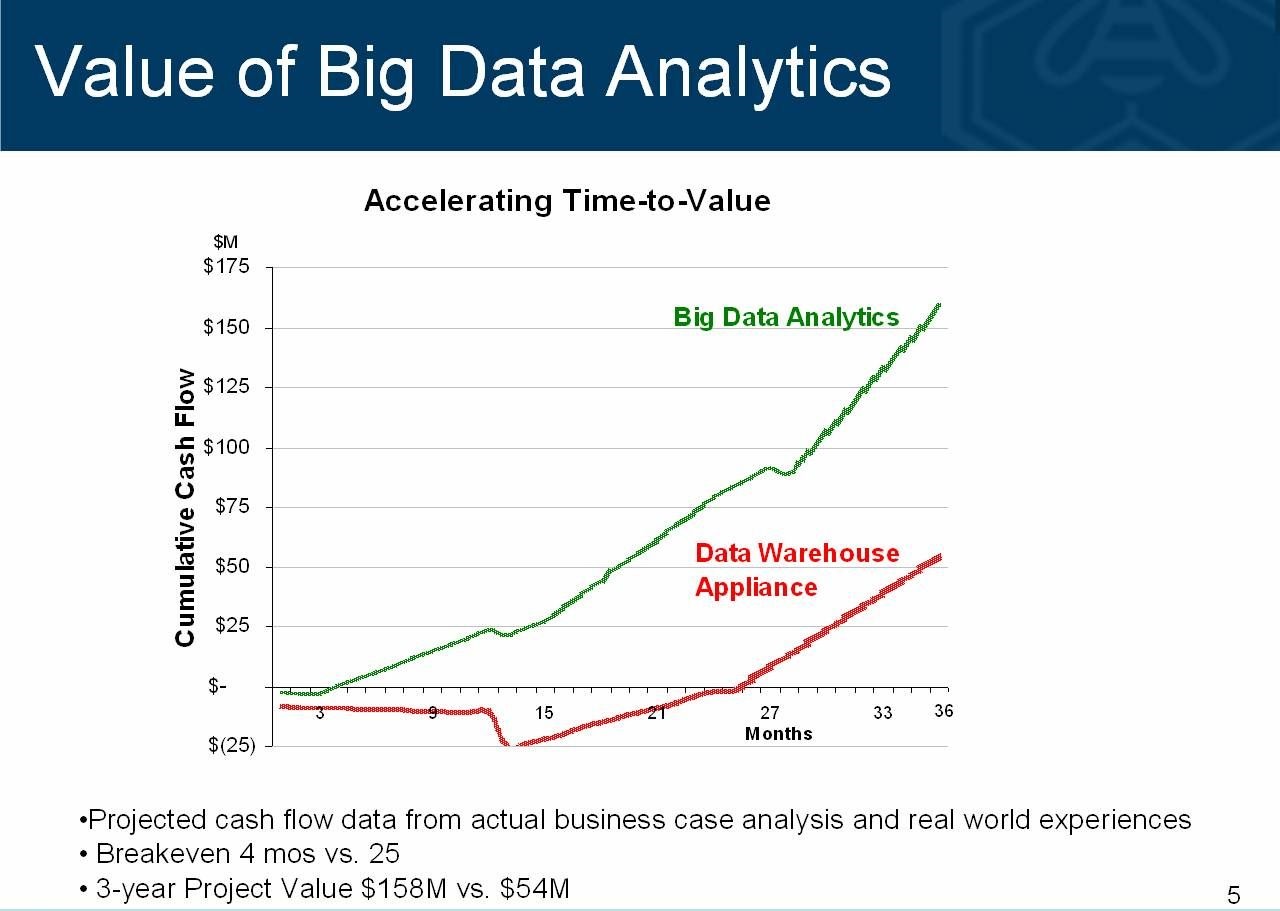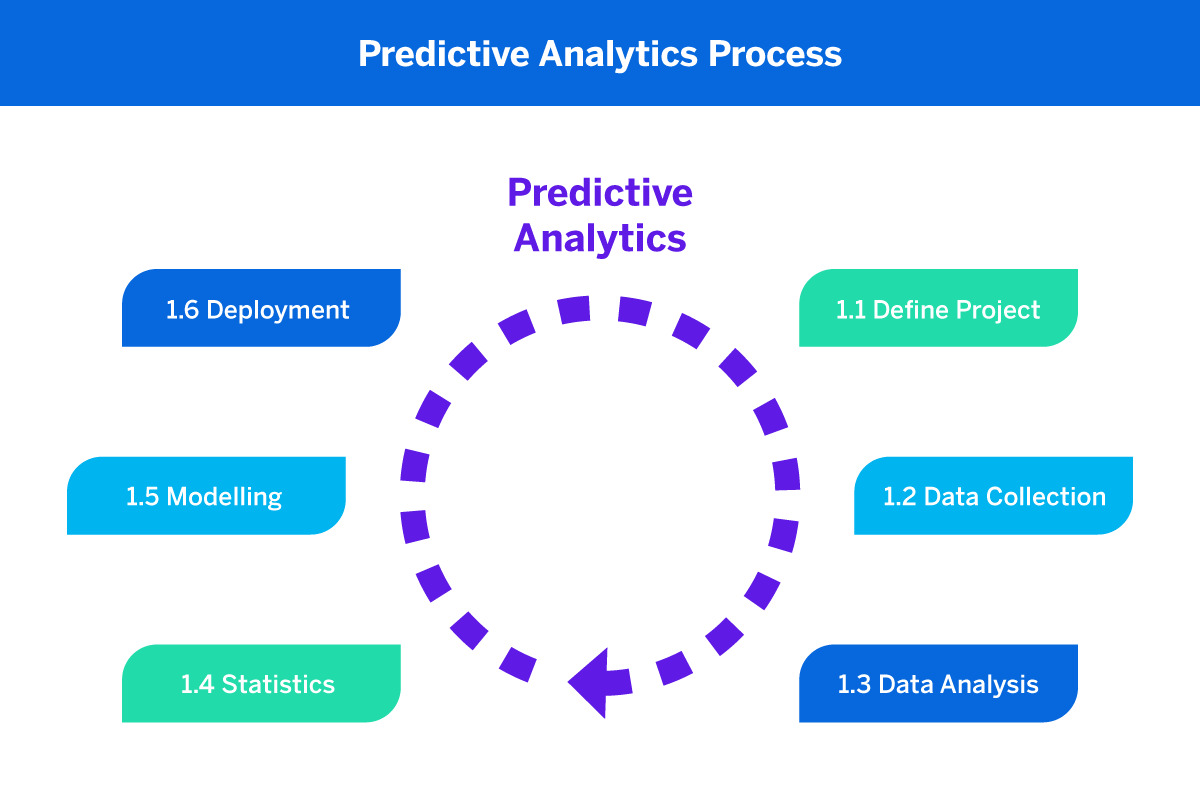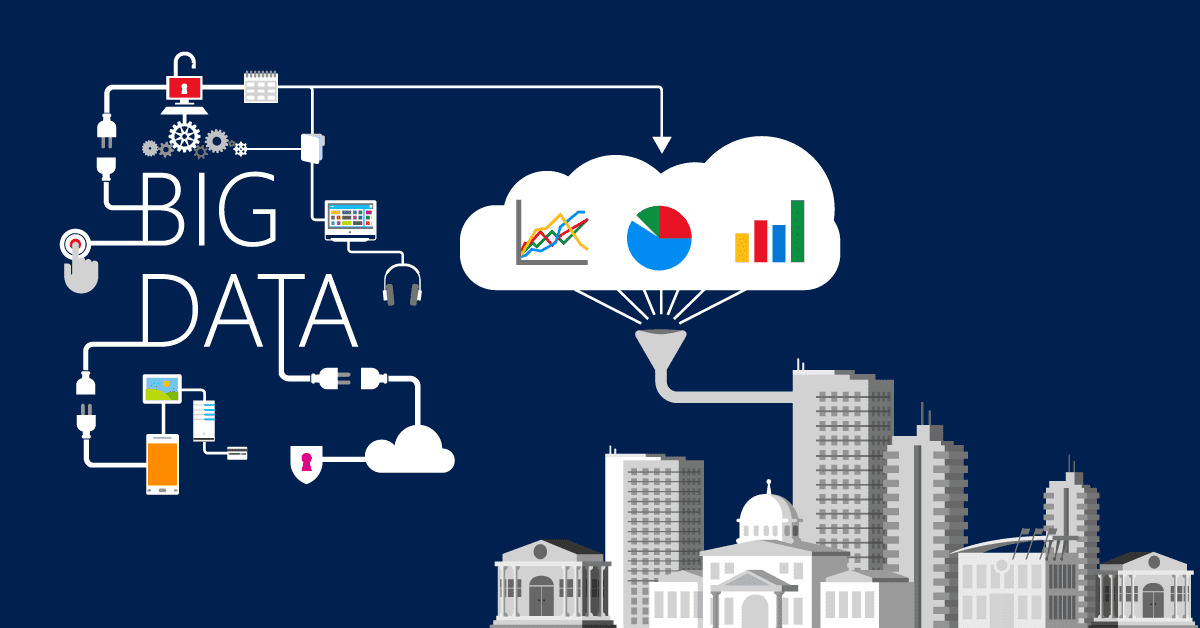Introduction
Big Data Analytics has emerged as a powerful tool for businesses in today’s data-driven world. With the increasing volume, variety, and velocity of data, organizations are now able to gain valuable insights and make informed decisions to drive revenue growth. Big Data Analytics encompasses the use of advanced statistical algorithms, predictive models, and machine learning techniques to analyze large datasets and extract meaningful information.
In this era of information overload, businesses are constantly faced with the challenge of leveraging data to their advantage. Big Data Analytics provides an effective solution by helping businesses uncover hidden patterns, identify trends, and gain deep customer insights. This ultimately allows companies to make data-driven decisions and enhance their revenue-generating capabilities.
By harnessing the power of Big Data Analytics, businesses can gain a competitive edge in the market. In this article, we will explore the importance of Big Data Analytics for businesses and how it can significantly increase revenue. We will delve into the various ways in which Big Data Analytics can be utilized to improve decision-making, personalize customer experiences, implement targeted marketing strategies, optimize pricing, enhance product development, and streamline operations.
Moreover, we will examine real-life case studies of businesses that have successfully utilized Big Data Analytics to boost their revenue. Additionally, we will discuss the challenges and limitations in implementing Big Data Analytics for revenue generation. Finally, we will provide the best practices for businesses looking to implement Big Data Analytics systems successfully.
By the end of this article, you will have a comprehensive understanding of how Big Data Analytics can revolutionize revenue generation for businesses in various industries. So, let’s dive into the world of Big Data Analytics and explore its potential to drive significant revenue growth.
The Importance of Big Data Analytics for Businesses
In today’s increasingly competitive business landscape, staying ahead of the curve is crucial for success. Big Data Analytics plays a pivotal role in helping businesses gain a competitive advantage by enabling them to extract valuable insights from vast amounts of data they accumulate. Here are some key reasons why Big Data Analytics is essential for businesses:
- Decision-Making: Big Data Analytics provides organizations with the ability to make data-driven decisions. By analyzing large datasets, businesses can identify patterns, trends, and correlations that can inform strategic decision-making. This helps reduce guesswork and intuition-based decisions, leading to more accurate and effective choices.
- Personalization: Today’s customers expect personalized experiences. Big Data Analytics enables businesses to understand their customers’ preferences, behaviors, and needs on a granular level. With this information, businesses can tailor their offerings, marketing campaigns, and customer interactions to deliver personalized experiences, which in turn leads to higher customer satisfaction and increased revenue.
- Targeted Marketing: Traditional marketing methods are often generic and mass-oriented. Big Data Analytics allows businesses to segment their customer base more effectively and target specific customer segments with personalized marketing messages. By delivering the right message to the right audience at the right time, businesses can improve conversion rates, increase customer engagement, and ultimately boost revenue.
- Optimal Pricing: Pricing strategies can greatly impact a business’s revenue. Big Data Analytics enables businesses to analyze market trends, competitors’ pricing, customer behavior, and other relevant factors to determine optimal pricing strategies. By leveraging this information, businesses can optimize their pricing to maximize revenue while ensuring competitive pricing in the market.
- Product Development: Big Data Analytics provides businesses with valuable insights into customer preferences, market trends, and emerging needs. By analyzing this data, businesses can identify gaps in the market and develop innovative products or enhance existing offerings to meet customer demands. This proactive approach to product development can drive revenue growth and maintain a competitive edge.
- Operational Efficiency: Big Data Analytics can help businesses streamline their operations and improve efficiency. By analyzing operational data, businesses can identify bottlenecks, inefficiencies, and areas of improvement. This allows for better resource allocation, process optimization, and cost reduction, ultimately leading to increased revenue and profitability.
Overall, Big Data Analytics has become an indispensable tool for businesses across industries. By leveraging the power of data, businesses can make better decisions, deliver personalized experiences, implement targeted marketing strategies, set optimal pricing, enhance product development, and streamline operations. The ability to harness the potential of Big Data Analytics is crucial for businesses looking to thrive in today’s data-driven world.
Understanding Big Data Analytics
Big Data Analytics is a process of extracting insights and meaningful information from large and complex datasets. It involves the use of advanced analytical techniques, such as statistical algorithms, machine learning, and data mining, to uncover patterns, trends, and correlations that can drive business decision-making and revenue growth.
There are three primary characteristics that define Big Data, known as the 3Vs: Volume, Velocity, and Variety. Volume refers to the enormous amount of data generated from various sources, including social media, transactional records, sensors, and more. Velocity refers to the speed at which data is generated and needs to be processed in real-time or near real-time. Lastly, Variety refers to the diverse types and formats of data, including structured, unstructured, and semi-structured data.
To effectively analyze Big Data, businesses employ various analytical techniques and technologies. These include:
- Data Collection: Businesses collect data from a multitude of sources, such as customer interactions, social media, web analytics, IoT devices, and more. The data is stored in data lakes or data warehouses, ready for analysis.
- Data Integration: Big Data Analytics involves integrating data from different sources and formats to create a unified view. This allows businesses to gain a comprehensive understanding of their data and derive meaningful insights.
- Data Cleaning and Preparation: Raw data often contains errors, inconsistencies, and missing values. Data cleaning and preparation involve processes like data filtering, normalization, and transformation to ensure the accuracy and quality of the data used for analysis.
- Data Exploration: This stage involves exploratory data analysis, where businesses use visualization techniques and statistical tools to gain an initial understanding of the data and identify interesting patterns or trends.
- Predictive Analytics: Predictive modeling enables businesses to make predictions and forecasts based on historical data. By applying statistical algorithms and machine learning techniques, organizations can anticipate future trends, customer behavior, and potential outcomes.
- Text Mining and Natural Language Processing (NLP): Unstructured data, such as social media posts, customer reviews, and emails, can provide valuable insights. Text mining and NLP techniques help extract meaningful information, sentiments, and themes from text data.
- Data Visualization: Communicating insights effectively is crucial. Data visualization techniques, such as charts, graphs, and dashboards, enable businesses to present complex data in a visually appealing and easy-to-understand manner.
Big Data Analytics enables businesses to transform raw data into actionable insights. By leveraging the power of advanced analytics techniques and technologies, organizations can harness the value of Big Data to drive revenue growth, enhance customer experiences, and gain a competitive edge in the market.
How Big Data Analytics Can Increase Business Revenue
Big Data Analytics has the potential to significantly impact a business’s revenue generation. By leveraging the insights derived from analyzing large and diverse datasets, businesses can make informed decisions and implement strategies that drive revenue growth. Here are some key ways in which Big Data Analytics can increase business revenue:
- Improved Decision-Making: Big Data Analytics provides businesses with deep insights into customer behavior, market trends, and operational efficiency. This knowledge allows organizations to make data-driven decisions, minimizing the guesswork and increasing the chances of making choices that lead to revenue growth.
- Personalized Customer Experiences: Personalization is key to attracting and retaining customers. Big Data Analytics enables businesses to understand their customers on a granular level, including their preferences, needs, and behavior patterns. By tailoring products, services, and marketing messages to individual customers, businesses can enhance customer satisfaction, increase loyalty, and ultimately drive revenue.
- Targeted Marketing Campaigns: Traditional mass marketing can be inefficient and yield low conversion rates. Big Data Analytics allows businesses to segment their customer base and create targeted marketing campaigns. By delivering personalized and relevant messages, businesses can increase customer engagement, improve conversion rates, and drive revenue growth.
- Optimized Pricing Strategies: Pricing directly impacts a company’s revenue. With Big Data Analytics, businesses can analyze market trends, competitor pricing, and customer preferences to determine optimal pricing strategies. By setting the right price points, businesses can maximize revenue and profitability while remaining competitive in the market.
- Enhanced Product Development: Big Data Analytics provides valuable insights into customer preferences, market demands, and emerging trends. By leveraging this information, businesses can develop innovative products, improve existing offerings, and cater to changing customer needs. This generates revenue by attracting new customers, increasing customer loyalty, and opening new market opportunities.
- Streamlined Operations: Big Data Analytics helps businesses identify inefficiencies and bottlenecks within their operations. By analyzing operational data, organizations can optimize their processes, reduce costs, and improve productivity. Streamlined operations result in improved efficiency, reduced waste, and increased revenue.
By implementing Big Data Analytics strategies and technologies, businesses can unlock the full potential of their data and transform it into revenue-generating opportunities. From making better decisions to delivering personalized experiences, targeting marketing efforts, optimizing pricing, enhancing product development, and streamlining operations, Big Data Analytics has become a game-changer for businesses looking to drive revenue growth in today’s data-driven world.
Improving Decision-Making with Big Data Analytics
Effective decision-making is crucial for the success of any business. Big Data Analytics empowers organizations to make more informed and accurate decisions by leveraging the vast amount of data available to them. Here are some key ways in which Big Data Analytics improves decision-making:
- Data-Driven Insights: Big Data Analytics enables businesses to extract valuable insights from large and diverse datasets. By analyzing historical and real-time data, businesses can identify patterns, trends, and correlations that provide actionable insights. These insights inform decision-making and help businesses make more informed choices based on data, rather than relying solely on intuition or guesswork.
- Predictive Analytics: By using predictive modeling techniques, businesses can anticipate future trends and outcomes. Big Data Analytics allows for the analysis of historical data to identify patterns and build models that can generate predictions. This enables businesses to make proactive decisions based on anticipated future events, giving them a competitive advantage and increasing the likelihood of revenue growth.
- Enhanced Market Intelligence: Big Data Analytics provides businesses with a comprehensive view of the market landscape. By analyzing market trends, competitor strategies, and customer behavior, organizations gain a deeper understanding of market dynamics. This knowledge helps businesses make better-informed decisions regarding market positioning, product development, and marketing strategies, which directly impact revenue generation.
- Risk Assessment and Mitigation: Big Data Analytics allows businesses to analyze data to identify potential risks and mitigate them effectively. By detecting patterns or anomalies in data, businesses can anticipate and prevent potential risks before they escalate. This proactive approach to risk management helps protect revenue streams and minimize financial losses.
- Real-time Decision-Making: With the increasing velocity of data, real-time decision-making is becoming more critical. Big Data Analytics enables businesses to process and analyze data in real-time, allowing for timely decision-making. This is especially valuable in dynamic industries where quick decisions are required to capitalize on opportunities and address arising challenges effectively.
- Resource Optimization: Big Data Analytics provides businesses with insights on resource allocation and optimization. By analyzing data related to operational efficiency, supply chain management, and customer demand, organizations can optimize their resource allocation, reducing costs and improving revenue generation. This enables businesses to allocate their resources more effectively and efficiently, maximizing revenue and profitability.
By leveraging Big Data Analytics, businesses can move away from making decisions based on mere intuition or limited information. Instead, they can make data-driven decisions that are supported by comprehensive insights and predictive capabilities. This enables organizations to make more accurate and informed decisions that positively impact revenue growth and overall business success.
Personalizing Customer Experiences with Big Data Analytics
In today’s hyper-competitive business landscape, delivering personalized customer experiences has become a key differentiator. Big Data Analytics plays a critical role in helping businesses understand their customers on a deeper level and create tailored experiences. Here are some ways in which Big Data Analytics enables personalization of customer experiences:
- Customer Segmentation: Big Data Analytics allows businesses to segment their customer base based on various attributes, such as demographics, purchase history, and online behavior. By segmenting customers into distinct groups, businesses can create personalized marketing messages, offers, and recommendations that resonate with each segment’s unique preferences and needs.
- 360-Degree Customer View: Big Data Analytics enables businesses to consolidate data from multiple touchpoints and channels, creating a comprehensive view of individual customers. This unified customer profile includes past interactions, purchase history, preferences, and feedback. With this holistic view, businesses can gain a deeper understanding of each customer and provide personalized experiences based on their preferences and needs.
- Real-Time Personalization: Big Data Analytics enables businesses to personalize customer experiences in real-time. By leveraging real-time data, such as browsing behavior, geographic location, and past purchase patterns, businesses can make personalized recommendations, offers, and content to engage customers at the right moment. Real-time personalization enhances customer satisfaction, increases engagement, and encourages repeat purchases.
- Behavioral Analysis: By analyzing customer behavior using Big Data Analytics, businesses can gain insights into individual preferences, interests, and intents. This information helps in tailoring product recommendations, offers, and marketing messages to each customer’s unique needs and preferences. Behavioral analysis enables businesses to anticipate customer needs, foster customer loyalty, and increase the likelihood of conversion and revenue growth.
- Predictive Personalization: Big Data Analytics helps businesses make predictions about customer behavior and preferences. By leveraging historical data and machine learning algorithms, businesses can anticipate customer needs and preferences, making personalized recommendations or offers in advance. Predictive personalization allows businesses to create a seamless and personalized customer journey, increasing customer satisfaction and revenue.
- Continuous Customer Engagement: Big Data Analytics enables businesses to engage customers through personalized interactions across various channels. By using customer data to tailor marketing messages, promotions, and content, businesses can create meaningful and relevant touchpoints that resonate with customers. Continuous customer engagement fosters brand loyalty, drives customer advocacy, and encourages repeat purchases, ultimately boosting revenue.
By leveraging Big Data Analytics, businesses can move beyond generic one-size-fits-all approaches and deliver personalized experiences that meet customers’ individual needs and expectations. Personalized customer experiences foster customer loyalty, increase customer satisfaction, and drive revenue by ensuring that customers feel valued and understood by the brand.
Targeted Marketing Using Big Data Analytics
Traditional mass marketing techniques are no longer as effective in capturing customer attention and driving conversions. Big Data Analytics has revolutionized marketing by enabling businesses to implement targeted marketing strategies. By leveraging the power of data, businesses can deliver relevant and personalized messages to their target audience, increasing engagement and driving revenue. Here are some ways in which Big Data Analytics helps businesses achieve targeted marketing:
- Customer Segmentation: Big Data Analytics allows businesses to segment their customer base into distinct groups based on various factors such as demographics, behavior, and preferences. This segmentation helps businesses understand their different customer segments and tailor their marketing messages to resonate with each group. By delivering targeted messages, businesses can increase the relevance and effectiveness of their marketing campaigns.
- Behavioral Analysis: Big Data Analytics enables businesses to analyze customer behavior and preferences to gain insights into individual interests and purchase patterns. By understanding customer behavior in real-time, businesses can deliver personalized recommendations, offers, and content to customers at the right moment. Behavioral analysis helps businesses target customers with relevant marketing messages and increase the likelihood of conversion.
- Predictive Modeling: With Big Data Analytics, businesses can leverage predictive modeling techniques to forecast customer behavior or likelihood to purchase. By analyzing historical data and applying machine learning algorithms, businesses can predict individual customer preferences, future purchases, or even churn rates. This allows businesses to implement targeted marketing strategies that focus on retaining existing customers and attracting new ones.
- Contextual Marketing: Big Data Analytics enables businesses to deliver marketing messages based on contextual information. By considering factors such as location, time, and device, businesses can deliver targeted messages that align with the customer’s situation. For example, a retail store might send a personalized offer to a nearby customer who frequently purchases similar items. Contextual marketing increases the relevance of the message and improves the chances of conversion.
- Omni-Channel Marketing: Big Data Analytics helps businesses achieve a unified view of customer interactions across multiple channels, including online and offline touchpoints. By analyzing data from various channels, businesses can gain insights into customer behavior, preferences, and engagement. This information allows businesses to deliver consistent and personalized experiences across channels, creating a seamless customer journey and increasing the effectiveness of marketing efforts.
- A/B Testing: Big Data Analytics enables businesses to conduct A/B testing on marketing campaigns. By testing different variations of marketing messages, offers, or designs, businesses can collect data and analyze the results to identify the most effective approaches. A/B testing helps businesses optimize their marketing strategies and increase conversion rates, leading to higher revenue generation.
By leveraging Big Data Analytics, businesses can move away from generic, spray-and-pray marketing approaches and deliver targeted messages that resonate with their audience. Targeted marketing increases engagement, improves conversion rates, and ultimately drives revenue by ensuring that marketing efforts are focused on reaching the right people with the right message at the right time.
Optimal Pricing Strategies with Big Data Analytics
Pricing plays a fundamental role in revenue generation for businesses. Big Data Analytics empowers businesses to implement optimal pricing strategies by analyzing market trends, competitor pricing, customer behavior, and other relevant factors. Here are some ways in which Big Data Analytics helps businesses set optimal pricing:
- Competitor Analysis: Big Data Analytics enables businesses to gather and analyze data on competitor pricing strategies. By monitoring competitors’ prices, businesses can gain insights into market trends, identify pricing gaps, and adjust their own pricing accordingly. This allows businesses to set prices that are competitive and attractive to customers, while still maintaining profitability.
- Customer Segmentation: Big Data Analytics allows businesses to segment their customer base based on different factors such as demographics, buying behaviors, and preferences. By analyzing customer data, businesses can understand the price sensitivity of each segment. This insight can be used to tailor pricing strategies specifically for each segment, maximizing revenue by offering the right price point for different customer groups.
- Demand Forecasting: Big Data Analytics enables businesses to forecast customer demand based on historical data and market trends. By analyzing patterns and seasonality, businesses can anticipate fluctuations in demand and adjust pricing accordingly. This helps businesses optimize revenue by setting prices that align with anticipated customer demand.
- Dynamic Pricing: Big Data Analytics allows businesses to implement dynamic pricing strategies based on real-time data. Utilizing advanced algorithms and machine learning models, businesses can adjust prices based on factors such as demand, inventory levels, competitor pricing, and customer behavior. Dynamic pricing ensures that prices are optimized to maximize revenue while still meeting market demands.
- Promotional Pricing: Big Data Analytics helps businesses evaluate the effectiveness of promotional pricing strategies. By analyzing customer response data and purchase behavior, businesses can determine the impact of different promotional pricing offers on revenue and profitability. This knowledge allows businesses to refine their promotional pricing strategies to drive sales and generate maximum revenue.
- Price Optimization: Big Data Analytics enables businesses to analyze multiple dimensions when setting prices, such as production costs, supply chain factors, customer preferences, and market competition. By considering these factors holistically, businesses can optimize pricing strategies to maximize revenue and profitability while staying competitive in the market.
The utilization of Big Data Analytics enables businesses to move beyond conventional pricing methods and embrace data-driven pricing approaches. By leveraging market insights, competitor analysis, customer segmentation, demand forecasting, dynamic pricing, and promotional pricing, businesses can set optimal prices that align with market dynamics and customer preferences. Optimized pricing strategies ultimately contribute to higher revenue generation while ensuring competitiveness and profitability.
Enhancing Product Development with Big Data Analytics
Big Data Analytics has revolutionized the traditional product development process by providing businesses with valuable insights into customer preferences, market trends, and emerging needs. By leveraging the power of data, businesses can enhance their product development efforts and create offerings that better align with customer expectations. Here are some ways in which Big Data Analytics enhances product development:
- Customer Insights: Big Data Analytics allows businesses to gather and analyze customer data to gain deep insights into their preferences, purchase patterns, and behaviors. By understanding customer needs and expectations, businesses can develop products that cater to those specific demands, increasing the likelihood of product success and revenue generation.
- Market Trends and Competitive Analysis: Big Data Analytics enables businesses to monitor and analyze market trends and competitor activities. By tracking market trends and analyzing competitors’ products, businesses can identify gaps and emerging opportunities. This insight guides product development, ensuring that businesses deliver innovative offerings that address market needs and stand out from the competition.
- Real-time Feedback: Big Data Analytics facilitates the collection and analysis of real-time feedback from customers. Through various channels such as social media, online reviews, and customer support interaction data, businesses can gather valuable feedback on existing products. This feedback can be used to identify areas for improvement and inform product enhancements or updates, leading to increased customer satisfaction and loyalty.
- Product Personalization: Big Data Analytics allows businesses to customize products based on individual customer preferences. By analyzing customer data and insights, businesses can identify opportunities for product personalization or customization. This enables businesses to offer tailored solutions that meet specific customer needs, enhancing the value proposition and driving revenue growth.
- Product Innovation: Through Big Data Analytics, businesses can identify emerging trends, technologies, and customer demands. By analyzing data related to customer feedback, purchasing behavior, and market trends, businesses can uncover opportunities for product innovation. This insight enables businesses to develop new products or enhance existing offerings based on market needs and preferences.
- Testing and Iteration: Big Data Analytics allows businesses to analyze data from product usage, feedback, and testing phases. By analyzing this data, businesses can evaluate product performance, identify areas for improvement, and make data-driven decisions throughout the product development lifecycle. This iterative approach helps businesses refine and optimize their products, increasing customer satisfaction and revenue potential.
The utilization of Big Data Analytics in product development enables businesses to make data-driven decisions, gain insights into customer preferences, stay ahead of market trends, and deliver innovative and customer-centric products. By leveraging the power of data, businesses can enhance their product offerings, increase customer satisfaction, and ultimately drive revenue growth.
Streamlining Operations and Improving Efficiency with Big Data Analytics
In today’s competitive business environment, it is crucial for organizations to streamline their operations and improve efficiency to stay ahead. Big Data Analytics plays a significant role in achieving this by providing businesses with valuable insights into their processes, identifying areas for improvement, and enabling data-driven decision-making. Here are some ways in which Big Data Analytics streamlines operations and improves efficiency:
- Data-Driven Insights: Big Data Analytics allows businesses to analyze vast amounts of operational data from various sources. This analysis provides insights into bottlenecks, inefficiencies, and areas of improvement across different processes. By understanding these insights, businesses can make data-driven decisions to optimize operations and drive efficiency.
- Supply Chain Optimization: Big Data Analytics helps businesses optimize their supply chains by analyzing data on inventory levels, demand patterns, and supplier performance. By understanding these factors, businesses can make informed decisions regarding procurement, inventory management, and logistics. Optimizing the supply chain leads to reduced costs, improved delivery times, and enhanced customer satisfaction.
- Process Automation: Big Data Analytics enables businesses to automate repetitive tasks and streamline processes. By analyzing data and identifying areas where automation can be implemented, businesses can reduce manual effort, minimize errors, and improve process efficiency. Automation also frees up employees to focus on higher-value tasks, increasing overall productivity.
- Predictive Maintenance: Big Data Analytics allows businesses to implement predictive maintenance strategies. By analyzing data from IoT sensors, equipment performance, and historical maintenance records, businesses can predict when machinery or equipment is likely to fail. This helps organizations schedule maintenance activities proactively, minimizing downtime, reducing costs, and optimizing operational efficiency.
- Real-Time Monitoring: Big Data Analytics enables businesses to monitor operations and performance in real-time. By analyzing data streams from sensors and other monitoring devices, businesses can identify issues as they occur and take immediate action. Real-time monitoring helps prevent potential problems from escalating, ensuring smooth operations and minimizing disruptions.
- Resource Optimization: Big Data Analytics allows businesses to analyze resource utilization and identify areas for optimization. By analyzing operational data, businesses can make informed decisions regarding resource allocation, workforce planning, and capacity management. This ensures that resources are allocated efficiently, minimizing waste and increasing overall operational efficiency.
By leveraging Big Data Analytics, businesses can optimize their operations, drive efficiency, and reduce costs. With data-driven insights, businesses can streamline processes, automate tasks, optimize the supply chain, implement predictive maintenance strategies, monitor operations in real-time, and optimize resource utilization. This results in improved operational efficiency, reduced costs, and increased revenue potential.
Case Studies: Businesses Increasing Revenue with Big Data Analytics
Several businesses across industries have successfully utilized Big Data Analytics to drive revenue growth and achieve business success. Let’s look at a few case studies that demonstrate how Big Data Analytics has helped businesses increase their revenue:
Case Study 1: Amazon
Amazon, the global e-commerce giant, is renowned for its use of Big Data Analytics to personalize customer experiences and drive revenue. Through its recommendation engine, powered by Big Data Analytics algorithms, Amazon delivers personalized product recommendations to millions of customers. By analyzing vast amounts of customer data, including previous purchases, browsing history, and demographic information, Amazon can provide highly relevant and targeted recommendations. This approach results in increased customer engagement, higher conversion rates, and ultimately, improved revenue for the company.
Case Study 2: Netflix
Netflix, the popular streaming platform, leverages Big Data Analytics to personalize content recommendations for its users. By analyzing customer viewing preferences, historical data, and interactions with content, Netflix can suggest movies and TV shows tailored to each user’s interests. This personalization strategy has contributed to increased customer satisfaction, higher retention rates, and ultimately, revenue growth for the company.
Case Study 3: Uber
Uber, the ride-sharing platform, relies heavily on Big Data Analytics to optimize its pricing strategy. By analyzing various factors such as demand patterns, traffic conditions, and customer behavior, Uber dynamically adjusts its fares in real-time. This dynamic pricing strategy helps Uber maximize revenue during high-demand periods and incentivizes drivers to be available in areas with high demand. By leveraging Big Data Analytics, Uber has been able to achieve significant revenue growth and create a highly efficient and responsive pricing model.
Case Study 4: Starbucks
Starbucks, the global coffeehouse chain, utilizes Big Data Analytics to enhance its loyalty program, Starbucks Rewards. By analyzing customer transaction data and preferences, Starbucks can customize offers, promotions, and rewards for individual customers. This personalized approach not only drives customer loyalty but also increases customer spending and frequency of visits. According to reports, members of the Starbucks Rewards program contribute significantly to the company’s revenue, showcasing the revenue-boosting potential of Big Data Analytics in customer loyalty programs.
These case studies highlight the transformative impact of Big Data Analytics on businesses’ revenue generation. By leveraging customer data, optimizing pricing strategies, personalizing customer experiences, and enhancing loyalty programs, these businesses have successfully increased revenue and achieved a competitive advantage in their respective industries. Big Data Analytics continues to disrupt traditional business models, enabling companies to unlock new revenue streams and drive business growth.
Challenges and Limitations of Big Data Analytics for Revenue Generation
While Big Data Analytics offers immense potential for businesses to drive revenue growth, it is essential to acknowledge and address the challenges and limitations associated with its implementation. Here are some of the key challenges and limitations of Big Data Analytics for revenue generation:
Data Quality and Accuracy: One of the significant challenges of Big Data Analytics is ensuring the quality and accuracy of the data. With large volumes of data coming from various sources, there is a risk of inconsistencies, errors, and incomplete information. Poor data quality can lead to incorrect analysis and flawed insights, negatively impacting revenue generation strategies.
Data Privacy and Security: Handling vast amounts of customer data requires ensuring data privacy and security. The collection and analysis of personal information necessitate compliance with data protection regulations and stringent security measures. Failure to handle data securely can lead to breaches, loss of customer trust, and potential legal repercussions, which can severely impact a company’s revenue.
Data Integration and Compatibility: Integrating data from multiple sources and formats can be a complex process. Incompatibilities between data systems and data silos can hinder the seamless integration and analysis of data. It requires efforts to ensure data compatibility, data standardization, and a centralized, integrated data infrastructure to derive meaningful insights for revenue generation.
Skills and Expertise: Extracting valuable insights from Big Data requires skilled data analysts, data scientists, and IT professionals. The shortage of professionals with Big Data Analytics expertise is a challenge faced by many organizations. Hiring and retaining qualified personnel may be difficult and costly, hindering the effective implementation of Big Data Analytics for revenue generation.
Costs and Infrastructure: Implementing Big Data Analytics requires significant investment in infrastructure, including storage, processing power, and analytical tools. The costs associated with setting up and maintaining high-performance data systems can be substantial. Additionally, scaling the infrastructure to handle increasing data volumes can pose financial challenges for businesses, particularly smaller organizations.
Ethical and Legal Concerns: The use of Big Data Analytics raises ethical concerns regarding privacy, consent, and the responsible use of customer data. Businesses must navigate the ethical and legal landscape to ensure compliance, transparency, and respect for customer privacy. Failing to address these concerns can not only harm a company’s reputation but also lead to legal repercussions and loss of revenue.
Overall, businesses considering the implementation of Big Data Analytics for revenue generation must carefully navigate these challenges and limitations. By addressing data quality, privacy, integration, skills, costs, and ethical concerns, businesses can mitigate the risks and harness the full potential of Big Data Analytics to drive revenue growth successfully.
Best Practices for Implementing Big Data Analytics
Implementing Big Data Analytics requires careful planning and execution to effectively harness the potential of data for revenue generation. Here are some best practices to consider when implementing Big Data Analytics:
Define Clear Business Objectives: Clearly define the business objectives and goals that you aim to achieve through Big Data Analytics. Whether it is increasing revenue, improving customer satisfaction, or optimizing operations, having a clear focus will guide the data analysis and decision-making processes.
Invest in Data Quality and Governance: Ensure that your data is of high quality, accuracy, and reliability. Implement data cleaning and validation processes to ensure the integrity of your data. Establish data governance policies to define roles, responsibilities, and data access controls. This ensures data consistency and compliance with privacy regulations.
Build a Scalable Infrastructure: Invest in a robust and scalable infrastructure to manage and process large volumes of data. Assess your current infrastructure and evaluate your needs in terms of storage, computing power, and analytical capabilities. Consider cloud-based solutions for scalability and flexibility.
Leverage Advanced Analytics Techniques: Deploy advanced analytics techniques such as machine learning, predictive modeling, and data mining to extract insights from your data. These techniques enable you to uncover patterns, trends, and correlations that can drive revenue growth and inform decision-making.
Invest in Data Visualization: Utilize data visualization tools to present insights and findings in a visual and easily understandable format. Visualization helps stakeholders across the organization quickly grasp the key takeaways, facilitating data-driven decision-making and collaboration.
Invest in Data Talent: Hire or train professionals with expertise in Big Data Analytics. Skilled data analysts, data scientists, and IT professionals play a crucial role in extracting insights from data and applying analytical techniques effectively. Building a team with the right expertise and skills will be key to success.
Continuously Evaluate and Refine: Regularly evaluate the performance of your Big Data Analytics initiatives and refine your strategies accordingly. Monitor key performance indicators (KPIs) related to revenue, customer satisfaction, and operational efficiency. Use performance metrics to identify areas for improvement and adjust your approach as needed.
Embrace a Data-Driven Culture: Foster a culture of data-driven decision-making across the organization. Encourage employees to actively use data and insights in their decision-making processes. Educate and train employees on the benefits of data-driven approaches and provide access to relevant data and analytics tools.
Implementing Big Data Analytics requires a holistic approach that encompasses people, processes, and technology. By aligning your business goals, investing in data quality and infrastructure, leveraging advanced analytics techniques, and cultivating a data-driven culture, you can effectively utilize Big Data Analytics to drive revenue growth and gain a competitive advantage.
Conclusion
Big Data Analytics has become an invaluable tool for businesses seeking to increase their revenue and drive growth. By harnessing the power of data, organizations can make informed decisions, deliver personalized customer experiences, implement targeted marketing strategies, optimize pricing, enhance product development, and streamline operations. The case studies of industry leaders such as Amazon, Netflix, Uber, and Starbucks demonstrate the transformative impact of Big Data Analytics on revenue generation.
However, the implementation of Big Data Analytics is not without its challenges. Ensuring data quality, addressing privacy concerns, integrating data from various sources, and acquiring the necessary skills and infrastructure are challenges that businesses must overcome. It is crucial to adopt best practices for a successful implementation, including defining clear business objectives, investing in data quality and governance, building a scalable infrastructure, leveraging advanced analytics techniques, investing in data talent, evaluating and refining strategies, and fostering a data-driven culture.
As businesses continue to navigate in a data-driven world, the importance of Big Data Analytics for revenue generation cannot be overlooked. It provides businesses with the tools and insights needed to make data-driven decisions, personalize customer experiences, optimize pricing strategies, innovate in product development, and streamline operations. Companies that embrace Big Data Analytics and effectively utilize the power of data are well-positioned to drive revenue growth, gain a competitive edge, and succeed in the fast-paced and data-intensive business landscape.

























